(All information courtesy of the instrument teams.)
![]() Previous IAU Circulars
Previous IAU Circulars
TITLE: GCN/SWIFT NOTICE
NOTICE_DATE: Sun 18 Apr 10 21:10:18 UT
NOTICE_TYPE: Swift-BAT GRB Position
TRIGGER_NUM: 419797, Seg_Num: 0
GRB_RA: 256.376d {+17h 05m 30s} (J2000),
256.497d {+17h 05m 59s} (current),
255.790d {+17h 03m 10s} (1950)
GRB_DEC: +11.464d {+11d 27' 50"} (J2000),
+11.451d {+11d 27' 02"} (current),
+11.531d {+11d 31' 51"} (1950)
GRB_ERROR: 3.00 [arcmin radius, statistical only]
GRB_INTEN: 5137 [cnts] Image_Peak=177 [image_cnts]
TRIGGER_DUR: 1.024 [sec]
TRIGGER_INDEX: 138 E_range: 15-50 keV
BKG_INTEN: 36422 [cnts]
BKG_TIME: 76194.28 SOD {21:09:54.28} UT
BKG_DUR: 8 [sec]
GRB_DATE: 15304 TJD; 108 DOY; 10/04/18
GRB_TIME: 76208.04 SOD {21:10:08.04} UT
GRB_PHI: 133.96 [deg]
GRB_THETA: 29.69 [deg]
SOLN_STATUS: 0x3
RATE_SIGNIF: 8.66 [sigma]
IMAGE_SIGNIF: 7.06 [sigma]
MERIT_PARAMS: +1 +0 +0 +0 +1 -3 +0 +0 +58 +0
SUN_POSTN: 26.69d {+01h 46m 46s} +11.02d {+11d 01' 09"}
SUN_DIST: 125.66 [deg] Sun_angle= 8.7 [hr] (West of Sun)
MOON_POSTN: 80.91d {+05h 23m 39s} +25.20d {+25d 12' 02"}
MOON_DIST: 143.10 [deg]
MOON_ILLUM: 20 [%]
GAL_COORDS: 31.47, 28.66 [deg] galactic lon,lat of the burst (or transient)
ECL_COORDS: 253.80, 34.14 [deg] ecliptic lon,lat of the burst (or transient)
COMMENTS: SWIFT-BAT GRB Coordinates.
COMMENTS: This is a rate trigger.
COMMENTS: A point_source was found.
COMMENTS: This does not match any source in the on-board catalog.
COMMENTS: This does not match any source in the ground catalog.
COMMENTS: This is a GRB.
COMMENTS: This trigger occurred at longitude,latitude = 83.89,-4.44 [deg].
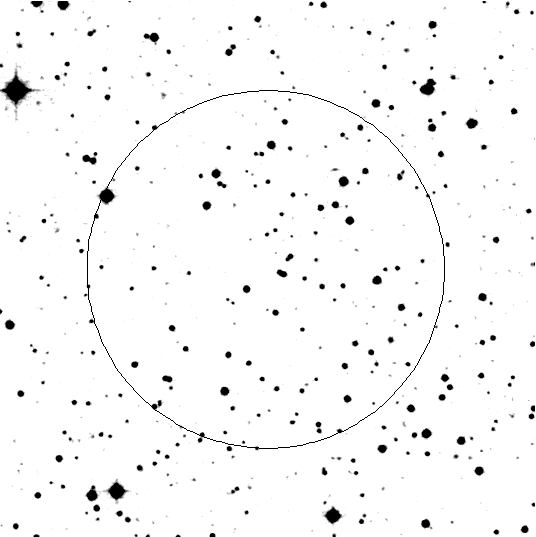
TITLE: GCN/SWIFT NOTICE
NOTICE_DATE: Sun 18 Apr 10 21:11:46 UT
NOTICE_TYPE: Swift-XRT Position
TRIGGER_NUM: 419797, Seg_Num: 0
GRB_RA: 256.3623d {+17h 05m 26.95s} (J2000),
256.4829d {+17h 05m 55.90s} (current),
255.7767d {+17h 03m 06.41s} (1950)
GRB_DEC: +11.4616d {+11d 27' 41.7"} (J2000),
+11.4481d {+11d 26' 53.3"} (current),
+11.5286d {+11d 31' 43.0"} (1950)
GRB_ERROR: 5.4 [arcsec radius, statistical plus systematic, 90% containment]
GRB_INTEN: 1.27e-09 [erg/cm2/sec]
GRB_SIGNIF: 7.81 [sigma]
IMG_START_DATE: 15304 TJD; 108 DOY; 10/04/18
IMG_START_TIME: 76287.13 SOD {21:11:27.13} UT, 79.1 [sec] since BAT Trigger Time
TAM[0-3]: 327.69 237.24 261.50 243.62
AMPLIFIER: 2
WAVEFORM: 134
SUN_POSTN: 26.69d {+01h 46m 46s} +11.02d {+11d 01' 11"}
SUN_DIST: 125.67 [deg] Sun_angle= 8.7 [hr] (West of Sun)
MOON_POSTN: 80.93d {+05h 23m 42s} +25.20d {+25d 12' 01"}
MOON_DIST: 143.10 [deg]
MOON_ILLUM: 20 [%]
GAL_COORDS: 31.46, 28.67 [deg] galactic lon,lat of the burst
ECL_COORDS: 253.79, 34.14 [deg] ecliptic lon,lat of the burst
COMMENTS: SWIFT-XRT Coordinates.
COMMENTS: The XRT position is 0.81 arcmin from the BAT position.
TITLE: GCN/SWIFT NOTICE
NOTICE_DATE: Sun 18 Apr 10 21:12:03 UT
NOTICE_TYPE: Swift-XRT Processed Image
TRIGGER_NUM: 419797, Seg_Num: 0
GRB_RA: 256.3623d {+17h 05m 26.9s} (J2000),
256.4829d {+17h 05m 55.9s} (current),
255.7767d {+17h 03m 06.4s} (1950)
GRB_DEC: +11.4616d {+11d 27' 41.7"} (J2000),
+11.4481d {+11d 26' 53.3"} (current),
+11.5286d {+11d 31' 43.0"} (1950)
GRB_ERROR: 5.4 [arcsec, radius, statistical plus systematic]
GRB_INTEN: 61 [cnts]
IMG_START_DATE: 15304 TJD; 108 DOY; 10/04/18
IMG_START_TIME: 76287.13 SOD {21:11:27.13} UT, 79.1 [sec] since BAT Trigger Time
CENTROID_X: 382.84, raw= 383 [pixels]
CENTROID_Y: 313.79, raw= 314 [pixels]
ROLL: 67.26 [deg]
GAIN: 1
MODE: 3, Long Image mode
WAVEFORM: 134
EXPO_TIME: 2.50 [sec]
GRB_POS_XRT_Y: 37.24
GRB_POS_XRT_Z: 189.87
IMAGE_URL: sw00419797000msxps_rw.img
SUN_POSTN: 26.69d {+01h 46m 46s} +11.02d {+11d 01' 11"}
SUN_DIST: 125.67 [deg] Sun_angle= 8.7 [hr] (West of Sun)
MOON_POSTN: 80.93d {+05h 23m 43s} +25.20d {+25d 12' 00"}
MOON_DIST: 143.10 [deg]
MOON_ILLUM: 20 [%]
GAL_COORDS: 31.46, 28.67 [deg] galactic lon,lat of the burst
ECL_COORDS: 253.79, 34.14 [deg] ecliptic lon,lat of the burst
COMMENTS: SWIFT-XRT Processed Image.

TITLE: GCN/SWIFT NOTICE
NOTICE_DATE: Sun 18 Apr 10 21:11:56 UT
NOTICE_TYPE: Swift-XRT Image
TRIGGER_NUM: 419797, Seg_Num: 0
GRB_RA: 256.3623d {+17h 05m 26.9s} (J2000),
256.4829d {+17h 05m 55.9s} (current),
255.7767d {+17h 03m 06.4s} (1950)
GRB_DEC: +11.4616d {+11d 27' 41.7"} (J2000),
+11.4481d {+11d 26' 53.3"} (current),
+11.5286d {+11d 31' 43.0"} (1950)
GRB_ERROR: 5.4 [arcsec, radius, statistical plus systematic]
GRB_INTEN: 61 [cnts]
IMG_START_DATE: 15304 TJD; 108 DOY; 10/04/18
IMG_START_TIME: 76287.13 SOD {21:11:27.13} UT, 79.1 [sec] since BAT Trigger Time
CENTROID_X: 382.84, raw= 383 [pixels]
CENTROID_Y: 313.79, raw= 314 [pixels]
ROLL: 67.26 [deg]
GAIN: 1
MODE: 3, Long Image mode
WAVEFORM: 134
EXPO_TIME: 2.50 [sec]
GRB_POS_XRT_Y: 37.24
GRB_POS_XRT_Z: 189.87
IMAGE_URL: sw00419797000msxps_rw.img
SUN_POSTN: 26.69d {+01h 46m 46s} +11.02d {+11d 01' 11"}
SUN_DIST: 125.67 [deg] Sun_angle= 8.7 [hr] (West of Sun)
MOON_POSTN: 80.93d {+05h 23m 43s} +25.20d {+25d 12' 00"}
MOON_DIST: 143.10 [deg]
MOON_ILLUM: 20 [%]
GAL_COORDS: 31.46, 28.67 [deg] galactic lon,lat of the burst
ECL_COORDS: 253.79, 34.14 [deg] ecliptic lon,lat of the burst
COMMENTS: SWIFT-XRT Image.

TITLE: GCN/SWIFT NOTICE
NOTICE_DATE: Sun 18 Apr 10 21:13:56 UT
NOTICE_TYPE: Swift-BAT GRB Lightcurve
TRIGGER_NUM: 419797, Seg_Num: 0
GRB_RA: 256.376d {+17h 05m 30s} (J2000),
256.497d {+17h 05m 59s} (current),
255.790d {+17h 03m 10s} (1950)
GRB_DEC: +11.464d {+11d 27' 50"} (J2000),
+11.451d {+11d 27' 02"} (current),
+11.531d {+11d 31' 51"} (1950)
GRB_DATE: 15304 TJD; 108 DOY; 10/04/18
GRB_TIME: 76208.04 SOD {21:10:08.04} UT
TRIGGER_INDEX: 138
GRB_PHI: 133.96 [deg]
GRB_THETA: 29.69 [deg]
DELTA_TIME: 64.00 [sec]
TRIGGER_DUR: 1.024 [sec]
SOLN_STATUS: 0x3
RATE_SIGNIF: 8.66 [sigma]
IMAGE_SIGNIF: 7.06 [sigma]
LC_URL: sw00419797000msb.lc
SUN_POSTN: 26.69d {+01h 46m 47s} +11.02d {+11d 01' 13"}
SUN_DIST: 125.66 [deg] Sun_angle= 8.7 [hr] (West of Sun)
MOON_POSTN: 80.95d {+05h 23m 48s} +25.20d {+25d 11' 59"}
MOON_DIST: 143.09 [deg]
MOON_ILLUM: 20 [%]
GAL_COORDS: 31.47, 28.66 [deg] galactic lon,lat of the burst (or transient)
ECL_COORDS: 253.80, 34.14 [deg] ecliptic lon,lat of the burst (or transient)
COMMENTS: SWIFT-BAT GRB Lightcurve.
COMMENTS:
COMMENTS: The next comments were copied from the BAT_POS Notice:
COMMENTS: This is a rate trigger.
COMMENTS: A point_source was found.
COMMENTS: This does not match any source in the on-board catalog.
COMMENTS: This does not match any source in the ground catalog.
COMMENTS: This is a GRB.
COMMENTS: This trigger occurred at longitude,latitude = 83.89,-4.44 [deg].
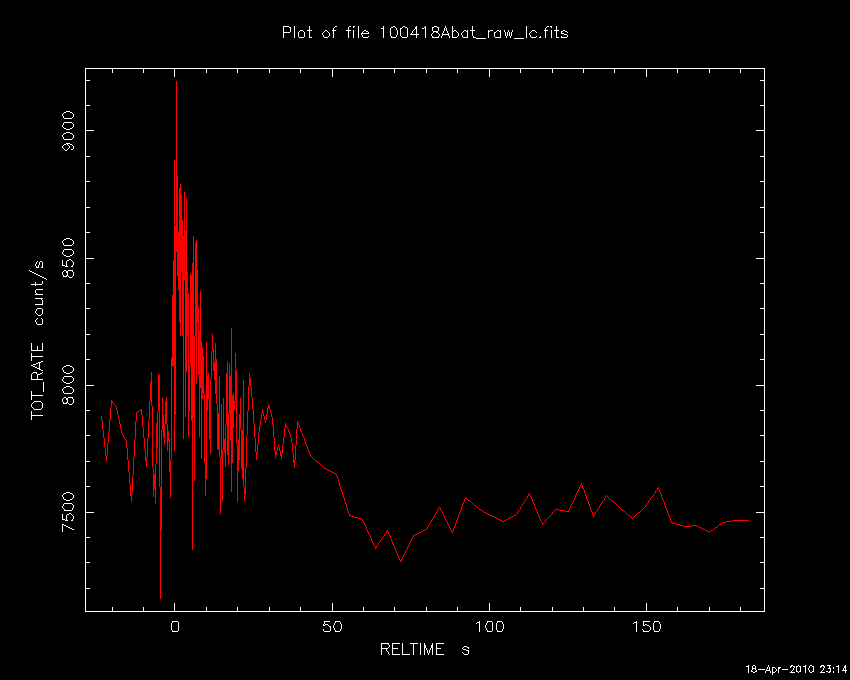
TITLE: GCN/SWIFT NOTICE
NOTICE_DATE: Sun 18 Apr 10 21:14:31 UT
NOTICE_TYPE: Swift-UVOT Source List
TRIGGER_NUM: 419797, Seg_Num: 0
POINT_RA: 256.416d {+17h 05m 40s} (J2000)
POINT_DEC: +11.473d {+11d 28' 22"} (J2000)
POINT_ROLL: 67.261d
IMG_START_DATE: 15304 TJD; 108 DOY; 10/04/18
IMG_START_TIME: 76295.62 SOD {21:11:35.62} UT, 87.6 [sec] since BAT Trigger Time
FILTER: 10, White
BKG_MEAN: 2.056
N_STARS: 119
X_OFFSET: 184 [pixels]
Y_OFFSET: 640 [pixels]
X_MAX: 1143 [pixels]
Y_MAX: 1599 [pixels]
DET_THRESH: 12
PHOTO_THRESH: 6
SL_URL: sw00419797000msufc0087.fits
SUN_POSTN: 26.69d {+01h 46m 47s} +11.02d {+11d 01' 13"}
SUN_DIST: 125.62 [deg] Sun_angle= 8.7 [hr] (West of Sun)
MOON_POSTN: 80.96d {+05h 23m 49s} +25.20d {+25d 11' 59"}
MOON_DIST: 143.09 [deg]
MOON_ILLUM: 20 [%]
GAL_COORDS: 31.50, 28.63 [deg] galactic lon,lat of the pointing direction
ECL_COORDS: 253.85, 34.15 [deg] ecliptic lon,lat of the pointing direction
COMMENTS: SWIFT-UVOT Source List.
TITLE: GCN/SWIFT NOTICE
NOTICE_DATE: Sun 18 Apr 10 21:15:01 UT
NOTICE_TYPE: Swift-UVOT Processed Source List
TRIGGER_NUM: 419797, Seg_Num: 0
POINT_RA: 256.416d {+17h 05m 40s} (J2000)
POINT_DEC: +11.473d {+11d 28' 22"} (J2000)
POINT_ROLL: 67.261d
IMG_START_DATE: 15304 TJD; 108 DOY; 10/04/18
IMG_START_TIME: 76295.62 SOD {21:11:35.62} UT, 87.6 [sec] since BAT Trigger Time
FILTER: 10, White
BKG_MEAN: 2.056
N_STARS: 119
X_OFFSET: 184 [pixels]
Y_OFFSET: 640 [pixels]
X_MAX: 1143 [pixels]
Y_MAX: 1599 [pixels]
DET_THRESH: 12
PHOTO_THRESH: 6
SL_URL: sw00419797000msufc0087.fits
SUN_POSTN: 26.69d {+01h 46m 47s} +11.02d {+11d 01' 14"}
SUN_DIST: 125.62 [deg] Sun_angle= 8.7 [hr] (West of Sun)
MOON_POSTN: 80.96d {+05h 23m 51s} +25.20d {+25d 11' 58"}
MOON_DIST: 143.09 [deg]
MOON_ILLUM: 20 [%]
GAL_COORDS: 31.50, 28.63 [deg] galactic lon,lat of the pointing direction
ECL_COORDS: 253.85, 34.15 [deg] ecliptic lon,lat of the pointing direction
COMMENTS: SWIFT-UVOT Processed Source List.
COMMENTS: All 4 attachments are included.
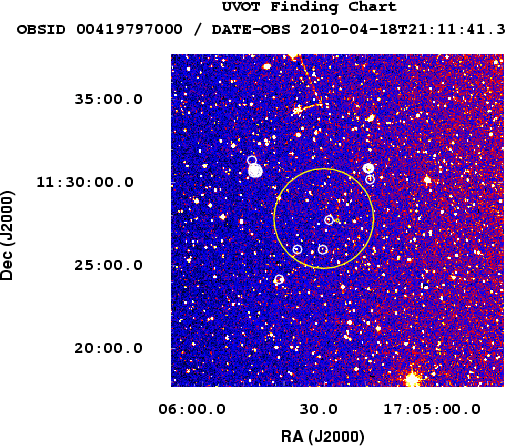
TITLE: GCN/SWIFT NOTICE
NOTICE_DATE: Sun 18 Apr 10 21:14:31 UT
NOTICE_TYPE: Swift-UVOT Source List
TRIGGER_NUM: 419797, Seg_Num: 0
POINT_RA: 256.416d {+17h 05m 40s} (J2000)
POINT_DEC: +11.473d {+11d 28' 22"} (J2000)
POINT_ROLL: 67.261d
IMG_START_DATE: 15304 TJD; 108 DOY; 10/04/18
IMG_START_TIME: 76295.62 SOD {21:11:35.62} UT, 87.6 [sec] since BAT Trigger Time
FILTER: 10, White
BKG_MEAN: 2.056
N_STARS: 119
X_OFFSET: 184 [pixels]
Y_OFFSET: 640 [pixels]
X_MAX: 1143 [pixels]
Y_MAX: 1599 [pixels]
DET_THRESH: 12
PHOTO_THRESH: 6
SL_URL: sw00419797000msufc0087.fits
SUN_POSTN: 26.69d {+01h 46m 47s} +11.02d {+11d 01' 13"}
SUN_DIST: 125.62 [deg] Sun_angle= 8.7 [hr] (West of Sun)
MOON_POSTN: 80.96d {+05h 23m 49s} +25.20d {+25d 11' 59"}
MOON_DIST: 143.09 [deg]
MOON_ILLUM: 20 [%]
GAL_COORDS: 31.50, 28.63 [deg] galactic lon,lat of the pointing direction
ECL_COORDS: 253.85, 34.15 [deg] ecliptic lon,lat of the pointing direction
COMMENTS: SWIFT-UVOT Source List.
TITLE: GCN/SWIFT NOTICE
NOTICE_DATE: Sun 18 Apr 10 21:15:56 UT
NOTICE_TYPE: Swift-UVOT Image
TRIGGER_NUM: 419797, Seg_Num: 0
POINT_RA: 256.416d {+17h 05m 40s} (J2000)
POINT_DEC: +11.473d {+11d 28' 22"} (J2000)
ROLL: 67.261d
IMG_START_DATE: 15304 TJD; 108 DOY; 10/04/18
IMG_START_TIME: 76295.62 SOD {21:11:35.62} UT, 87.6 [sec] since BAT Trigger Time
FILTER: 10, White
EXPOSURE_ID: 293317901
X_OFFSET: 417 [pixels]
Y_OFFSET: 981 [pixels]
WIDTH: 160 [pixels]
HEIGHT: 160 [pixels]
X_GRB_POS: 577
Y_GRB_POS: 1141
BINNING_INDEX: 1
IM_URL: sw00419797000msuni0093.fits
SUN_POSTN: 26.70d {+01h 46m 47s} +11.02d {+11d 01' 14"}
SUN_DIST: 125.62 [deg] Sun_angle= 8.7 [hr] (West of Sun)
MOON_POSTN: 80.97d {+05h 23m 53s} +25.20d {+25d 11' 58"}
MOON_DIST: 143.09 [deg]
MOON_ILLUM: 20 [%]
GAL_COORDS: 31.50, 28.63 [deg] galactic lon,lat of the pointing direction
ECL_COORDS: 253.85, 34.15 [deg] ecliptic lon,lat of the pointing direction
COMMENTS: SWIFT-UVOT Image.
COMMENTS: The GRB Position came from the XRT Position Command.
COMMENTS: The image has 2x2 binning (compression).
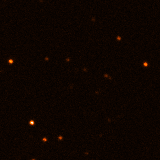
TITLE: GCN/SWIFT NOTICE
NOTICE_DATE: Sun 18 Apr 10 21:16:23 UT
NOTICE_TYPE: Swift-UVOT Processed Image
TRIGGER_NUM: 419797, Seg_Num: 0
POINT_RA: 256.416d {+17h 05m 40s} (J2000)
POINT_DEC: +11.473d {+11d 28' 22"} (J2000)
ROLL: 67.261d
IMG_START_DATE: 15304 TJD; 108 DOY; 10/04/18
IMG_START_TIME: 76295.62 SOD {21:11:35.62} UT, 87.6 [sec] since BAT Trigger Time
FILTER: 10, White
EXPOSURE_ID: 293317901
X_OFFSET: 417 [pixels]
Y_OFFSET: 981 [pixels]
WIDTH: 160 [pixels]
HEIGHT: 160 [pixels]
X_GRB_POS: 577
Y_GRB_POS: 1141
BINNING_INDEX: 1
IM_URL: sw00419797000msuni0093.fits
SUN_POSTN: 26.70d {+01h 46m 47s} +11.02d {+11d 01' 15"}
SUN_DIST: 125.62 [deg] Sun_angle= 8.7 [hr] (West of Sun)
MOON_POSTN: 80.98d {+05h 23m 54s} +25.20d {+25d 11' 57"}
MOON_DIST: 143.09 [deg]
MOON_ILLUM: 20 [%]
GAL_COORDS: 31.50, 28.63 [deg] galactic lon,lat of the pointing direction
ECL_COORDS: 253.85, 34.15 [deg] ecliptic lon,lat of the pointing direction
COMMENTS: SWIFT-UVOT Processed Image.
COMMENTS: The GRB Position came from the XRT Position Command.
COMMENTS: The image has 2x2 binning (compression).
COMMENTS: All 4 attachments are included.
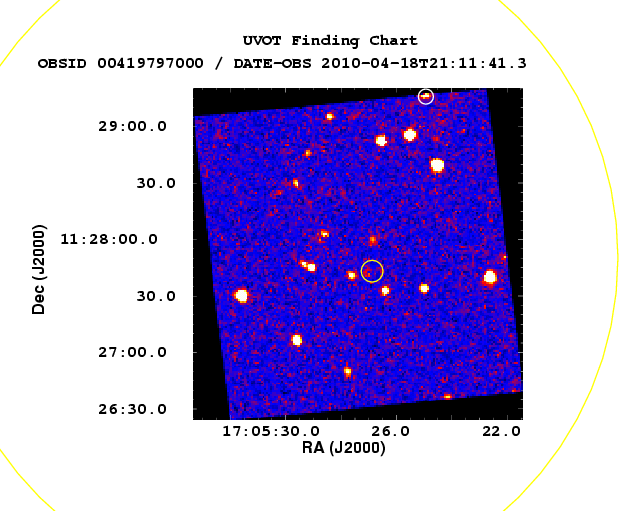
TITLE: GCN/SWIFT NOTICE
NOTICE_DATE: Sun 18 Apr 10 21:23:18 UT
NOTICE_TYPE: Swift-UVOT Source List
TRIGGER_NUM: 419797, Seg_Num: 0
POINT_RA: 256.417d {+17h 05m 40s} (J2000)
POINT_DEC: +11.471d {+11d 28' 15"} (J2000)
POINT_ROLL: 67.263d
IMG_START_DATE: 15304 TJD; 108 DOY; 10/04/18
IMG_START_TIME: 76507.49 SOD {21:15:07.49} UT, 299.5 [sec] since BAT Trigger Time
FILTER: 7, U
BKG_MEAN: 0.528
N_STARS: 67
X_OFFSET: 97 [pixels]
Y_OFFSET: 661 [pixels]
X_MAX: 1056 [pixels]
Y_MAX: 1620 [pixels]
DET_THRESH: 7
PHOTO_THRESH: 3
SL_URL: sw00419797000msufc0299.fits
SUN_POSTN: 26.70d {+01h 46m 48s} +11.02d {+11d 01' 21"}
SUN_DIST: 125.62 [deg] Sun_angle= 8.7 [hr] (West of Sun)
MOON_POSTN: 81.05d {+05h 24m 11s} +25.20d {+25d 11' 52"}
MOON_DIST: 143.08 [deg]
MOON_ILLUM: 20 [%]
GAL_COORDS: 31.50, 28.62 [deg] galactic lon,lat of the pointing direction
ECL_COORDS: 253.85, 34.15 [deg] ecliptic lon,lat of the pointing direction
COMMENTS: SWIFT-UVOT Source List.
TITLE: GCN/SWIFT NOTICE
NOTICE_DATE: Sun 18 Apr 10 21:23:18 UT
NOTICE_TYPE: Swift-UVOT Source List
TRIGGER_NUM: 419797, Seg_Num: 0
POINT_RA: 256.417d {+17h 05m 40s} (J2000)
POINT_DEC: +11.471d {+11d 28' 15"} (J2000)
POINT_ROLL: 67.263d
IMG_START_DATE: 15304 TJD; 108 DOY; 10/04/18
IMG_START_TIME: 76507.49 SOD {21:15:07.49} UT, 299.5 [sec] since BAT Trigger Time
FILTER: 7, U
BKG_MEAN: 0.528
N_STARS: 67
X_OFFSET: 97 [pixels]
Y_OFFSET: 661 [pixels]
X_MAX: 1056 [pixels]
Y_MAX: 1620 [pixels]
DET_THRESH: 7
PHOTO_THRESH: 3
SL_URL: sw00419797000msufc0299.fits
SUN_POSTN: 26.70d {+01h 46m 48s} +11.02d {+11d 01' 21"}
SUN_DIST: 125.62 [deg] Sun_angle= 8.7 [hr] (West of Sun)
MOON_POSTN: 81.05d {+05h 24m 11s} +25.20d {+25d 11' 52"}
MOON_DIST: 143.08 [deg]
MOON_ILLUM: 20 [%]
GAL_COORDS: 31.50, 28.62 [deg] galactic lon,lat of the pointing direction
ECL_COORDS: 253.85, 34.15 [deg] ecliptic lon,lat of the pointing direction
COMMENTS: SWIFT-UVOT Source List.
TITLE: GCN/SWIFT NOTICE
NOTICE_DATE: Sun 18 Apr 10 21:23:46 UT
NOTICE_TYPE: Swift-UVOT Processed Source List
TRIGGER_NUM: 419797, Seg_Num: 0
POINT_RA: 256.417d {+17h 05m 40s} (J2000)
POINT_DEC: +11.471d {+11d 28' 15"} (J2000)
POINT_ROLL: 67.263d
IMG_START_DATE: 15304 TJD; 108 DOY; 10/04/18
IMG_START_TIME: 76507.49 SOD {21:15:07.49} UT, 299.5 [sec] since BAT Trigger Time
FILTER: 7, U
BKG_MEAN: 0.528
N_STARS: 67
X_OFFSET: 97 [pixels]
Y_OFFSET: 661 [pixels]
X_MAX: 1056 [pixels]
Y_MAX: 1620 [pixels]
DET_THRESH: 7
PHOTO_THRESH: 3
SL_URL: sw00419797000msufc0299.fits
SUN_POSTN: 26.70d {+01h 46m 48s} +11.02d {+11d 01' 21"}
SUN_DIST: 125.62 [deg] Sun_angle= 8.7 [hr] (West of Sun)
MOON_POSTN: 81.05d {+05h 24m 12s} +25.20d {+25d 11' 52"}
MOON_DIST: 143.08 [deg]
MOON_ILLUM: 20 [%]
GAL_COORDS: 31.50, 28.62 [deg] galactic lon,lat of the pointing direction
ECL_COORDS: 253.85, 34.15 [deg] ecliptic lon,lat of the pointing direction
COMMENTS: SWIFT-UVOT Processed Source List.
COMMENTS: All 4 attachments are included.
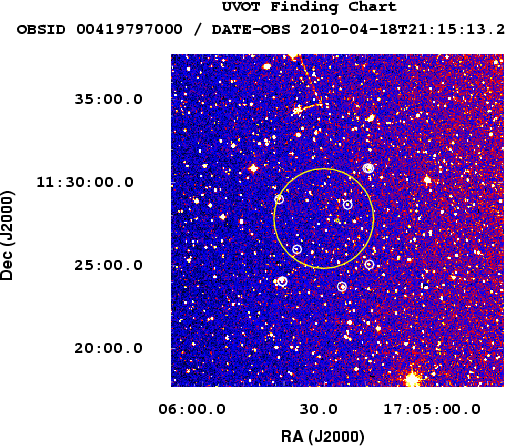
TITLE: GCN/SWIFT NOTICE
NOTICE_DATE: Sun 18 Apr 10 21:24:32 UT
NOTICE_TYPE: Swift-UVOT Image
TRIGGER_NUM: 419797, Seg_Num: 0
POINT_RA: 256.417d {+17h 05m 40s} (J2000)
POINT_DEC: +11.471d {+11d 28' 15"} (J2000)
ROLL: 67.263d
IMG_START_DATE: 15304 TJD; 108 DOY; 10/04/18
IMG_START_TIME: 76507.49 SOD {21:15:07.49} UT, 299.5 [sec] since BAT Trigger Time
FILTER: 7, U
EXPOSURE_ID: 293318113
X_OFFSET: 417 [pixels]
Y_OFFSET: 981 [pixels]
WIDTH: 160 [pixels]
HEIGHT: 160 [pixels]
X_GRB_POS: 577
Y_GRB_POS: 1141
BINNING_INDEX: 1
IM_URL: sw00419797000msuni0305.fits
SUN_POSTN: 26.70d {+01h 46m 48s} +11.02d {+11d 01' 22"}
SUN_DIST: 125.62 [deg] Sun_angle= 8.7 [hr] (West of Sun)
MOON_POSTN: 81.06d {+05h 24m 14s} +25.20d {+25d 11' 52"}
MOON_DIST: 143.08 [deg]
MOON_ILLUM: 20 [%]
GAL_COORDS: 31.50, 28.62 [deg] galactic lon,lat of the pointing direction
ECL_COORDS: 253.85, 34.15 [deg] ecliptic lon,lat of the pointing direction
COMMENTS: SWIFT-UVOT Image.
COMMENTS: The GRB Position came from the XRT Position Command.
COMMENTS: The image has 2x2 binning (compression).
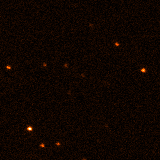
TITLE: GCN/SWIFT NOTICE
NOTICE_DATE: Sun 18 Apr 10 21:24:39 UT
NOTICE_TYPE: Swift-XRT Position UPDATE
TRIGGER_NUM: 419797, Seg_Num: 0
GRB_RA: 256.3634d {+17h 05m 27.21s} (J2000),
256.4840d {+17h 05m 56.16s} (current),
255.7778d {+17h 03m 06.67s} (1950)
GRB_DEC: +11.4618d {+11d 27' 42.4"} (J2000),
+11.4483d {+11d 26' 54.0"} (current),
+11.5288d {+11d 31' 43.7"} (1950)
GRB_ERROR: 3.1 [arcsec radius, statistical plus systematic, 90% containment]
GRB_INTEN: 1.00e-10 [erg/cm2/sec]
GRB_SIGNIF: 10.00 [sigma]
IMG_START_DATE: 15304 TJD; 108 DOY; 10/04/18
IMG_START_TIME: 76393.00 SOD {21:13:13.00} UT, 185.0 [sec] since BAT Trigger Time
TAM[0-3]: 100.00 100.00 100.00 100.00
AMPLIFIER: 1
WAVEFORM: 31
SUN_POSTN: 26.70d {+01h 46m 48s} +11.02d {+11d 01' 22"}
SUN_DIST: 125.68 [deg] Sun_angle= 8.7 [hr] (West of Sun)
MOON_POSTN: 81.06d {+05h 24m 15s} +25.20d {+25d 11' 51"}
MOON_DIST: 143.08 [deg]
MOON_ILLUM: 20 [%]
GAL_COORDS: 31.46, 28.67 [deg] galactic lon,lat of the burst
ECL_COORDS: 253.79, 34.14 [deg] ecliptic lon,lat of the burst
COMMENTS: SWIFT-XRT Coordinates.
COMMENTS: This Notice was ground-generated -- not flight-generated.
COMMENTS: This is an Update Notice -- the RA,Dec values herein supersede the previous XRT_POS Notice.
COMMENTS: TAM values, flux and significance fields are not valid.
COMMENTS: This position was automatically generated on the ground using
COMMENTS: Photon Counting data telemetered via TDRSS (SPER data).
COMMENTS: See http://www.swift.ac.uk/sper/docs.php for details.
COMMENTS: This position was enhanced using UVOT field astrometry.
COMMENTS: The probability that this is a serendipitous source in the
COMMENTS: SPER window is 0.11% < P(seren) < 0.58%.
TITLE: GCN/SWIFT NOTICE
NOTICE_DATE: Sun 18 Apr 10 21:24:53 UT
NOTICE_TYPE: Swift-UVOT Processed Image
TRIGGER_NUM: 419797, Seg_Num: 0
POINT_RA: 256.417d {+17h 05m 40s} (J2000)
POINT_DEC: +11.471d {+11d 28' 15"} (J2000)
ROLL: 67.263d
IMG_START_DATE: 15304 TJD; 108 DOY; 10/04/18
IMG_START_TIME: 76507.49 SOD {21:15:07.49} UT, 299.5 [sec] since BAT Trigger Time
FILTER: 7, U
EXPOSURE_ID: 293318113
X_OFFSET: 417 [pixels]
Y_OFFSET: 981 [pixels]
WIDTH: 160 [pixels]
HEIGHT: 160 [pixels]
X_GRB_POS: 577
Y_GRB_POS: 1141
BINNING_INDEX: 1
IM_URL: sw00419797000msuni0305.fits
SUN_POSTN: 26.70d {+01h 46m 48s} +11.02d {+11d 01' 22"}
SUN_DIST: 125.62 [deg] Sun_angle= 8.7 [hr] (West of Sun)
MOON_POSTN: 81.06d {+05h 24m 15s} +25.20d {+25d 11' 51"}
MOON_DIST: 143.08 [deg]
MOON_ILLUM: 20 [%]
GAL_COORDS: 31.50, 28.62 [deg] galactic lon,lat of the pointing direction
ECL_COORDS: 253.85, 34.15 [deg] ecliptic lon,lat of the pointing direction
COMMENTS: SWIFT-UVOT Processed Image.
COMMENTS: The GRB Position came from the XRT Position Command.
COMMENTS: The image has 2x2 binning (compression).
COMMENTS: All 4 attachments are included.
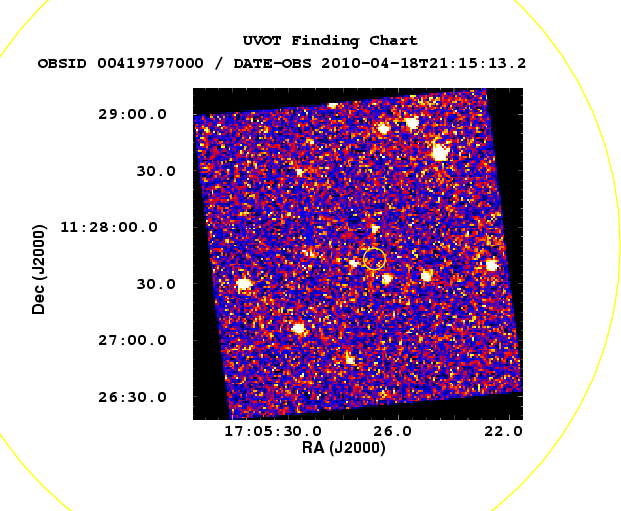
RA(J2000) = 17h 05m 30s Dec(J2000) = +11d 27' 50"with an uncertainty of 3 arcmin (radius, 90% containment, including systematic uncertainty). The BAT light curve showed a single-peaked structure with a duration of about 4 sec. The peak count rate was ~700 counts/sec (15-350 keV), at ~0 sec after the trigger.
RA(J2000) = 17h 05m 27.24s Dec(J2000) = +11d 27' 42.7"with an uncertainty of 3.1 arcseconds (radius, 90% containment). This location is 44 arcseconds from the BAT onboard position, within the BAT error circle. This position may be improved as more data are received; the latest position is available at http://www.swift.ac.uk/sper.
RA(J2000.0) = 17:05:26.96 = 256.36233 (deg)
Dec(J2000.0) = +11:27:41.9 = +11.46164 (deg)
with an estimated uncertainty of 1.0 arcsec (radius, 90% confidence,
statistical + systematic). The estimated white magnitude is 20.7 +/-
0.3. No correction has been made for the expected extinction
corresponding to E(B-V) of 0.07.
TITLE: GCN/SWIFT NOTICE
NOTICE_DATE: Sun 18 Apr 10 21:30:23 UT
NOTICE_TYPE: Swift-UVOT Source List
TRIGGER_NUM: 419797, Seg_Num: 0
POINT_RA: 256.417d {+17h 05m 40s} (J2000)
POINT_DEC: +11.471d {+11d 28' 15"} (J2000)
POINT_ROLL: 67.263d
IMG_START_DATE: 15304 TJD; 108 DOY; 10/04/18
IMG_START_TIME: 77085.61 SOD {21:24:45.61} UT, 877.6 [sec] since BAT Trigger Time
FILTER: 10, White
BKG_MEAN: 2.289
N_STARS: 190
X_OFFSET: 0 [pixels]
Y_OFFSET: 421 [pixels]
X_MAX: 1439 [pixels]
Y_MAX: 1860 [pixels]
DET_THRESH: 12
PHOTO_THRESH: 6
SL_URL: sw00419797000msufc0877.fits
SUN_POSTN: 26.70d {+01h 46m 49s} +11.02d {+11d 01' 27"}
SUN_DIST: 125.63 [deg] Sun_angle= 8.7 [hr] (West of Sun)
MOON_POSTN: 81.12d {+05h 24m 29s} +25.20d {+25d 11' 47"}
MOON_DIST: 143.07 [deg]
MOON_ILLUM: 20 [%]
GAL_COORDS: 31.50, 28.62 [deg] galactic lon,lat of the pointing direction
ECL_COORDS: 253.85, 34.15 [deg] ecliptic lon,lat of the pointing direction
COMMENTS: SWIFT-UVOT Source List.
TITLE: GCN/SWIFT NOTICE
NOTICE_DATE: Sun 18 Apr 10 21:30:58 UT
NOTICE_TYPE: Swift-UVOT Processed Source List
TRIGGER_NUM: 419797, Seg_Num: 0
POINT_RA: 256.417d {+17h 05m 40s} (J2000)
POINT_DEC: +11.471d {+11d 28' 15"} (J2000)
POINT_ROLL: 67.263d
IMG_START_DATE: 15304 TJD; 108 DOY; 10/04/18
IMG_START_TIME: 77085.61 SOD {21:24:45.61} UT, 877.6 [sec] since BAT Trigger Time
FILTER: 10, White
BKG_MEAN: 2.289
N_STARS: 190
X_OFFSET: 0 [pixels]
Y_OFFSET: 421 [pixels]
X_MAX: 1439 [pixels]
Y_MAX: 1860 [pixels]
DET_THRESH: 12
PHOTO_THRESH: 6
SL_URL: sw00419797000msufc0877.fits
SUN_POSTN: 26.71d {+01h 46m 49s} +11.02d {+11d 01' 27"}
SUN_DIST: 125.63 [deg] Sun_angle= 8.7 [hr] (West of Sun)
MOON_POSTN: 81.13d {+05h 24m 30s} +25.20d {+25d 11' 47"}
MOON_DIST: 143.07 [deg]
MOON_ILLUM: 20 [%]
GAL_COORDS: 31.50, 28.62 [deg] galactic lon,lat of the pointing direction
ECL_COORDS: 253.85, 34.15 [deg] ecliptic lon,lat of the pointing direction
COMMENTS: SWIFT-UVOT Processed Source List.
COMMENTS: All 4 attachments are included.
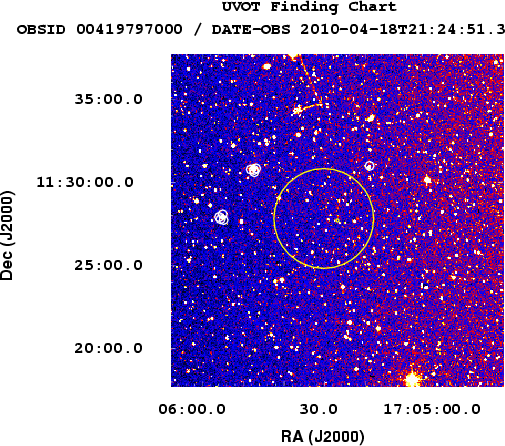
TITLE: GCN/SWIFT NOTICE
NOTICE_DATE: Sun 18 Apr 10 21:31:44 UT
NOTICE_TYPE: Swift-UVOT Image
TRIGGER_NUM: 419797, Seg_Num: 0
POINT_RA: 256.417d {+17h 05m 40s} (J2000)
POINT_DEC: +11.471d {+11d 28' 15"} (J2000)
ROLL: 67.263d
IMG_START_DATE: 15304 TJD; 108 DOY; 10/04/18
IMG_START_TIME: 77085.61 SOD {21:24:45.61} UT, 877.6 [sec] since BAT Trigger Time
FILTER: 10, White
EXPOSURE_ID: 293318691
X_OFFSET: 559 [pixels]
Y_OFFSET: 980 [pixels]
WIDTH: 160 [pixels]
HEIGHT: 160 [pixels]
X_GRB_POS: 719
Y_GRB_POS: 1140
BINNING_INDEX: 1
IM_URL: sw00419797000msuni0883.fits
SUN_POSTN: 26.71d {+01h 46m 49s} +11.02d {+11d 01' 28"}
SUN_DIST: 125.63 [deg] Sun_angle= 8.7 [hr] (West of Sun)
MOON_POSTN: 81.13d {+05h 24m 32s} +25.20d {+25d 11' 46"}
MOON_DIST: 143.07 [deg]
MOON_ILLUM: 20 [%]
GAL_COORDS: 31.50, 28.62 [deg] galactic lon,lat of the pointing direction
ECL_COORDS: 253.85, 34.15 [deg] ecliptic lon,lat of the pointing direction
COMMENTS: SWIFT-UVOT Image.
COMMENTS: The GRB Position came from the Window Position in the Mode Command.
COMMENTS: The image has 2x2 binning (compression).
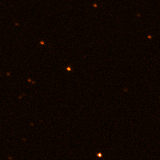
TITLE: GCN/SWIFT NOTICE
NOTICE_DATE: Sun 18 Apr 10 21:30:23 UT
NOTICE_TYPE: Swift-UVOT Source List
TRIGGER_NUM: 419797, Seg_Num: 0
POINT_RA: 256.417d {+17h 05m 40s} (J2000)
POINT_DEC: +11.471d {+11d 28' 15"} (J2000)
POINT_ROLL: 67.263d
IMG_START_DATE: 15304 TJD; 108 DOY; 10/04/18
IMG_START_TIME: 77085.61 SOD {21:24:45.61} UT, 877.6 [sec] since BAT Trigger Time
FILTER: 10, White
BKG_MEAN: 2.289
N_STARS: 190
X_OFFSET: 0 [pixels]
Y_OFFSET: 421 [pixels]
X_MAX: 1439 [pixels]
Y_MAX: 1860 [pixels]
DET_THRESH: 12
PHOTO_THRESH: 6
SL_URL: sw00419797000msufc0877.fits
SUN_POSTN: 26.70d {+01h 46m 49s} +11.02d {+11d 01' 27"}
SUN_DIST: 125.63 [deg] Sun_angle= 8.7 [hr] (West of Sun)
MOON_POSTN: 81.12d {+05h 24m 29s} +25.20d {+25d 11' 47"}
MOON_DIST: 143.07 [deg]
MOON_ILLUM: 20 [%]
GAL_COORDS: 31.50, 28.62 [deg] galactic lon,lat of the pointing direction
ECL_COORDS: 253.85, 34.15 [deg] ecliptic lon,lat of the pointing direction
COMMENTS: SWIFT-UVOT Source List.
TITLE: GCN/SWIFT NOTICE
NOTICE_DATE: Sun 18 Apr 10 21:32:02 UT
NOTICE_TYPE: Swift-UVOT Processed Image
TRIGGER_NUM: 419797, Seg_Num: 0
POINT_RA: 256.417d {+17h 05m 40s} (J2000)
POINT_DEC: +11.471d {+11d 28' 15"} (J2000)
ROLL: 67.263d
IMG_START_DATE: 15304 TJD; 108 DOY; 10/04/18
IMG_START_TIME: 77085.61 SOD {21:24:45.61} UT, 877.6 [sec] since BAT Trigger Time
FILTER: 10, White
EXPOSURE_ID: 293318691
X_OFFSET: 559 [pixels]
Y_OFFSET: 980 [pixels]
WIDTH: 160 [pixels]
HEIGHT: 160 [pixels]
X_GRB_POS: 719
Y_GRB_POS: 1140
BINNING_INDEX: 1
IM_URL: sw00419797000msuni0883.fits
SUN_POSTN: 26.71d {+01h 46m 49s} +11.02d {+11d 01' 28"}
SUN_DIST: 125.63 [deg] Sun_angle= 8.7 [hr] (West of Sun)
MOON_POSTN: 81.14d {+05h 24m 33s} +25.20d {+25d 11' 46"}
MOON_DIST: 143.07 [deg]
MOON_ILLUM: 20 [%]
GAL_COORDS: 31.50, 28.62 [deg] galactic lon,lat of the pointing direction
ECL_COORDS: 253.85, 34.15 [deg] ecliptic lon,lat of the pointing direction
COMMENTS: SWIFT-UVOT Processed Image.
COMMENTS: The GRB Position came from the Window Position in the Mode Command.
COMMENTS: The image has 2x2 binning (compression).
COMMENTS: All 4 attachments are included.
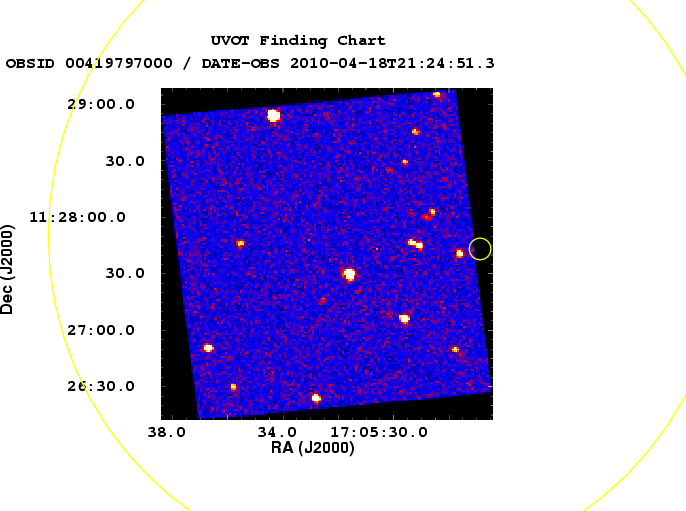
TITLE: GCN/SWIFT NOTICE
NOTICE_DATE: Sun 18 Apr 10 21:34:36 UT
NOTICE_TYPE: Swift-UVOT Position
TRIGGER_NUM: 419797, Seg_Num: 0
GRB_RA: 256.3623d {+17h 05m 26.95s} (J2000),
256.4829d {+17h 05m 55.90s} (current),
255.7767d {+17h 03m 06.41s} (1950)
GRB_DEC: +11.4616d {+11d 27' 41.7"} (J2000),
+11.4481d {+11d 26' 53.3"} (current),
+11.5286d {+11d 31' 43.0"} (1950)
GRB_ERROR: 10.0 [arcsec radius, statistical only]
GRB_MAG: 19.10 +/- 3.00 [mag]
FILTER: 10, White
IMG_START_DATE: 15304 TJD; 108 DOY; 10/04/18
IMG_START_TIME: 76299.00 SOD {21:11:39.00} UT, 91.0 [sec] since BAT Trigger Time
SUN_POSTN: 26.71d {+01h 46m 50s} +11.03d {+11d 01' 31"}
SUN_DIST: 125.68 [deg] Sun_angle= 8.7 [hr] (West of Sun)
MOON_POSTN: 81.16d {+05h 24m 40s} +25.20d {+25d 11' 44"}
MOON_DIST: 143.07 [deg]
MOON_ILLUM: 20 [%]
GAL_COORDS: 31.46, 28.67 [deg] galactic lon,lat of the burst (or transient)
ECL_COORDS: 253.79, 34.14 [deg] ecliptic lon,lat of the burst (or transient)
COMMENTS: SWIFT UVOT Position Notice.
COMMENTS: This Notice was ground-generated -- not flight-generated.
COMMENTS: The UVOT position is 0.4 arcsec from the XRT position.
start UT end UT t_exp(s) mlim t_start-tGRB(s) Coadd? -------------------------------------------------------------------- 21:10:30.6 21:10:35.6 5 15.4 16.7 N 21:10:30.6 21:12:37.9 127 16.8 16.7 YFurther observations are ongoing.
RA (J2000): 17h 05m 27.18s Dec (J2000): +11d 27' 40.1"with an uncertainty of 1.9 arcsec (radius, 90% confidence).
RA(J2000) = 17h 05m 25.8s Dec(J2000) = +11d 27' 26.8"with an uncertainty of 1.9 arcmin, (radius, sys+stat, 90% containment). The partial coding was 49%.
17:05:27.09, 11:27:42.3with an uncertainty of 0.5" in each coordinate and estimate the following preliminary magnitudes (in the AB system):
g' = 19.2 +- 0.1 r' = 18.8 +- 0.1 i' = 18.4 +- 0.1 z' = 18.1 +- 0.1 J = 17.7 +- 0.1Given magnitudes are calibrated against SDSS field stars and are not corrected for the expected Galactic foreground extinction corresponding to a reddening of E_(B-V)=0.07 mag in the direction of the burst (Schlegel et al. 1998).
17:05:27.09, 11:27:42.3with an uncertainty of 0.5" in each coordinate and estimate the following preliminary magnitudes (in the AB system):
g' = 19.2 +- 0.1 r' = 18.8 +- 0.1 i' = 18.4 +- 0.1 z' = 18.1 +- 0.1 J = 17.7 +- 0.1Given magnitudes are calibrated against SDSS field stars and are not corrected for the expected Galactic foreground extinction corresponding to a reddening of E_(B-V)=0.07 mag in the direction of the burst (Schlegel et al. 1998).
u: not detected g = 22.89 +- 0.17 r = 22.41 +- 0.16 i = 21.94 +- 0.17 z: not detectedSee e.g. http://cas.sdss.org/astrodr7/en/tools/explore/obj.asp?id=758879770841908118
RA(J2000.0) = 17:05:26.96 = 256.36278 (deg)
Dec(J2000.0) = +11:27:41.9 = +11.46167 (deg)
with a 90% confidence interval of 0."67.
FILTER T_start(s) T_stop Exposure Mag/3UL ======================================================== white fc 87 237 147 20.62+-0.29 white 89 1548 390 20.58+-0.20 white 6143 6343 196 20.32+-0.20 v 628 6754 491 >19.90 b 554 6138 294 20.61+-.44 u 299 7348 697 20.47+-0.41 uvw1 678 7164 491 20.47+-0.42 uvm2 653 6959 491 20.09+-0.32 uvw2 604 6548 308 20.73+-0.54 =======================================================The above magnitudes are not corrected for the Galactic extinction corresponding to a reddening of E_{B-V} = 0.07 (Schlegel et al., 1998, ApJS, 500, 525). The photometry is on the UVOT photometric system described in Poole et al. (2008, MNRAS, 383, 627).
post burst t_mid (hr) exp.(hr) filt mag m_err 11.13 0.92 J 16.8 0.1 11.13 0.92 H 15.9 0.1 11.13 0.92 Ks 15.3 0.1We note that our J band point is consistent with little to no fading since the GROND detection ~3.6 hours prior (using J_AB = J_2mass + 0.90). This is consistent with the shallow decay implied by the R band magnitudes in this time period reported thus far (Filgas et al., GCN 10617; Updike et al., GCN 10619; Antonelli et al., GCN 10620; Pearson et al., GCN 10626), and with the the non-fading behavior seen in the UVOT data (Siegel et al., GCN 10625). Further, the XRT light curve is roughly flat between ~1000s and ~1 day (see http://astro.berkeley.edu/~nat/Swift/00419797/xrt/swx00419797.html), indicating a long optical/X-ray plateau phase. Continued observations are encouraged.
T0+ Filter, Exposure, mag. (mid, d) (s) 0.1883 R 9x180 18.54 +/-0.03A finding char can be found at http://grb.rssi.ru/GRB100418A/GRB100418a_100418_R_azt11.gif
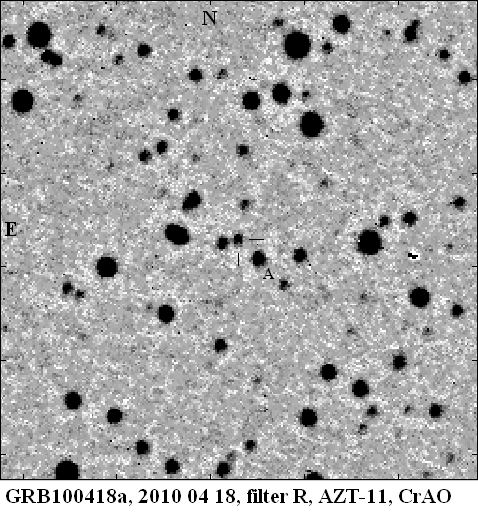
April 18 UT (T-T0),h Rc err ================================= 21:43 0.5 20.29 +/-0.10 22:38 1.5 >20.50 3-sigma image limit 23:25 2.25 18.64 +/-0.04 23:51 2.6 18.30 +/-0.04 23:58 2.9 18.33 +/-0.02 ================================= April 20 UT (T-T0),h Rc err ================================= 00:40 27.5 18.88 +/-0.03RTT-150 data shows that brightness of OT sharply increased from 20 to 18 mag at (T-T0) ~ 2 hours. The OT was observed at maximum brigtness atapproximately 2.6 hours after the burst and then its flux started to decline, which is consistent with other measurements made later on (Rumyantsev et al., GCN 10634, Filgas et al GCN 10617).
UT (T-T0), h Rc err ================================= 00:48 51.6 20.05 +/-0.03
band dt/days mag
V 21.5 24.5
R 22.5 23.7
I 24.0 22.9
J 29.5 22.8
This message can be cited.
FILTER T_start(s) T_stop Exposure Mag ========================================================= white fc 88 237 147 20.62+-0.29 white 88 1548 390 20.58+-0.20 white 6143 6343 196 20.32+-0.20 white 50996 52990 1959 19.38+-0.03 white 86204 92193 2308 19.77+-0.04 white 149282 156466 3812 20.54+-0.06 =========================================================The above magnitudes are not corrected for the Galactic extinction corresponding to a reddening of E_{B-V} = 0.07 (Schlegel et al., 1998, ApJS, 500, 525). The photometry is on the UVOT photometric system described in Poole et al. (2008, MNRAS, 383, 627).
post burst t_mid (hr) exp.(hr) filt mag m_err 35.81 1.27 J 18.0 0.1 35.81 1.27 H 17.2 0.1 35.81 1.27 Ks 16.3 0.1All magnitudes are given in the Vega system, calibrated to 2MASS. No correction for Galactic extinction has been made to the above reported values.
post burst t_mid(hr) exp.(min) filter mag. error 37.18 25 35.91 35.25Poor weather prevented observations on 2010-04-21 and 2010-04-22
post burst t_mid(hr) exp.(min) filter mag. error 37.18 25 B 19.9 0.15 35.91 25 V 19.3 0.1 35.25 20 R 18.5 0.1Poor weather has prevented subsequent observations.
T0+ � � � Filter, � Exposure, � �mag. � � � � � �L (mid, d) � � � � � �(s) 2.0175 � R � � � � 50x180 � � � 19.85 +/- 0.18 � 20.8
Date UT (T-T0),h Rc err Apr.24 00:20 123.1 20.6 +/-0.10 Apr.28 00:50 220.0 21.25 +/-0.05Preliminary Rc-light curve can be found at: http://hea.iki.rssi.ru/grb/100418a/indexeng.html
g = 22.67 =B1 0.07 R = 21.85 =B1 0.05The g-band magnitude is marginally consistent with the SDSS magnitude=20 (Malesani et al., GCN 10621) of g =3D 22.89 =B1 0.17, and suggests that t= he=20 UVOT flattening (Marshall et al., GCN 10720) is primarily due to the=20 host galaxy, not an associated supernova. Our reported R-band magnitude=20 is significantly brighter than the host, but this excess is consistent=20 with an afterglow origin (Bikmaev et al., GCN 10726). Additional=20 follow-up observations will be necessary to comment on the presence (or=20 absence) of a supernova counterpart.
T0+ Filter, Exposure, mag. (mid, d) (s) 26.0332 R 90x60 21.86 +/-0.06The photometry is compatible with R-magnitude reported by Perley et al, GCN 10727 (R=21.85+/-0.05 at 17.739 days) and still brighter than assumed R-magnitude of the normal type of host galaxy (SDSS based ugriz-> R conversion) which cannot be explained solely by afterglow contribution fading steeper than power law with decay index of .~0.8.
T0+ Filter, Exposure, seeing, mag. (mid, d) (s) 4.0793 R 11x300 0.7 20.56 +/- 0.02 19.0821 R 6x300 1.3 22.05 +/- 0.25
T0+ Filter, Exposure, mag. (mid, d) (s) 53.9919 R 88x60 22.05 +/-0.07The brightness of the host is less but compatible with early reported magnitudes on May 14 (R = 21.86 +/-0.06; GCN 10783) and (Rc = 21.90 +/-0.03; GCN 10794)